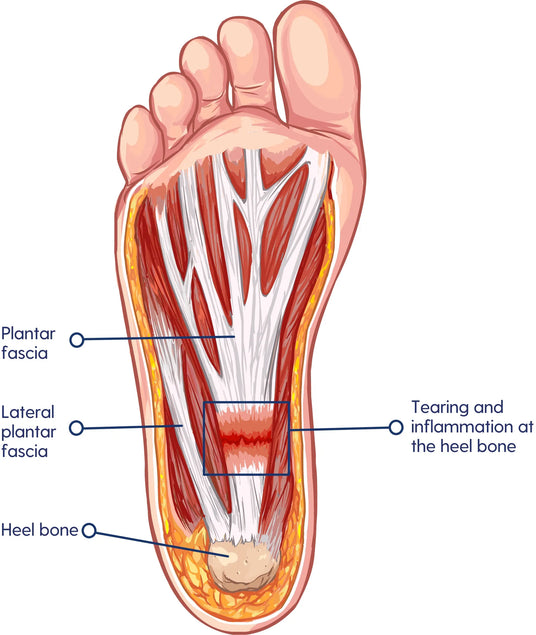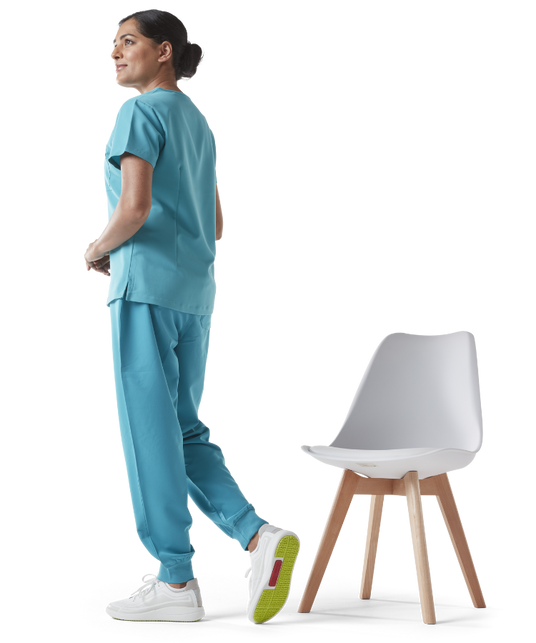If you've ever experienced that persistent, sharp, stabbing pain in your heel, especially with your first steps out of bed in the morning or after periods of rest, you're likely familiar with plantar fasciitis. This common orthopaedic complaint can cause nagging discomfort that makes everyday activities, from walking to standing for long periods, almost unbearable.
At Toffeln, we understand the profound impact foot pain can have on your life. For over 45 years, we have been the trusted footwear choice for healthcare professionals across the UK – those who spend long hours on their feet and truly understand the demands placed on them. This deep expertise in foot health and comfort is woven into every shoe we create. Our specialised range is designed to provide targeted relief, exceptional support, and lasting comfort, helping you get back to living life without constant pain. Choosing the right shoe, with the correct fit and support, is essential for effective plantar fasciitis relief.

Understanding Plantar Fasciitis: Causes, Symptoms & Relief
Plantar fasciitis is an inflammation of the plantar fascia, a thick band of tissue that runs across the bottom of your foot, connecting your heel bone to your toes. This condition affects an estimated 1 in 10 people in their lifetime.
The most common cause of plantar fasciitis is repetitive strain or excessive pressure on the plantar fascia, often from activities like running, standing for long periods, or wearing unsupportive shoes. Walking or standing on hard surfaces without supportive shoes can worsen symptoms. It is important to choose shoes with enough cushioning to absorb impact, provide support, and aid recovery.
Common Symptoms of Plantar Fasciitis:
The most common symptom is a sharp, stabbing pain in the heel, particularly noticeable:
- First thing in the morning when you step out of bed.
- After periods of rest, such as sitting for a long time or driving.
- After prolonged walking, standing, or running.
- Other symptoms can include stiffness in the heel and tenderness in the arch of the foot.
What Causes Plantar Fasciitis?
While the exact cause isn't always clear, plantar fasciitis often results from constant straining of the plantar fascia. Contributing factors can include:
- Over-pronation: When your feet roll inward excessively while walking.
- Unsupportive Footwear: Wearing shoes with insufficient arch support, poor cushioning, or overly flexible soles.
- Tight Calf Muscles: Tightness in the calf muscles and Achilles tendon can increase strain on the plantar fascia.
- Increased Activity: A rapid increase in physical activity or prolonged standing.
- Foot Anatomy: Conditions like flat feet or high arches can predispose individuals to plantar fasciitis.
- Body Weight: Excessive weight gain, including during pregnancy, can put additional stress on the feet.

Why Choose Toffeln Plantar Fasciitis Shoes?
Our deep understanding of foot biomechanics, honed over decades of serving UK healthcare professionals, allows us to craft footwear that truly makes a difference. The Toffeln SmartSole range provides targeted relief and support for plantar fasciitis sufferers, with a focus on overall stability in footwear for those at risk.
Key Features & Benefits of Toffeln SmartSole Technology:
Cupped Insole & Contoured Footbed: Our unique design actively prevents your feet from flattening and limits pronation, which are key factors in managing this painful condition. This helps to naturally realign the foot and distribute pressure evenly.
Customisable Arch Support: The SmartSole range offers customizable arch support, providing extra support around the mid-foot to minimise heel impact and evenly distribute your weight. The SmartSole range come with three free insoles, allowing you to choose the perfect fit and level of comfort for your unique anatomy.
Firm Raised Heels & Cushioned Soles: Our shoes feature firm raised heels that act as insulation between your foot and the floor, sharing weight equally throughout your foundation. This minimises impact on your feet, knees, and lower back, ensuring long-lasting comfort even during long hours of standing or walking.
Enhanced Stability & Grip-Safe Sole: Stable shoes prevent excessive foot movement, which can aggravate plantar fasciitis. Our Grip-Safe sole helps prevent slips and falls, offering greater penetration resistance and peace of mind, especially in demanding work environments.
Soft Interiors: Designed to reduce friction and irritation, making them ideal for sensitive feet.
This holistic approach helps ease the pain of plantar fasciitis and allows you to stay active and comfortable throughout your day. Discover the Toffeln difference and experience the comfort and support you deserve.
Our Plantar Fasciitis Shoe Range
-
£79.95Unit price /Unavailable
-
£79.95Unit price /Unavailable
-
Toffeln SmartSole Breeze Slip On
£74.95Unit price /Unavailable -
Toffeln SmartSole Breeze Trainer
£74.95Unit price /Unavailable
Beyond Footwear: Comprehensive Relief for Plantar Fasciitis
While supportive footwear is crucial, a holistic approach to managing plantar fasciitis can provide even greater relief. Consider incorporating these strategies into your routine:
- Regular Stretching: Keep your calf muscles and Achilles tendon limber to reduce strain on the plantar fascia. Simple stretches, like standing on the edge of a step and bending your knees, can be highly effective for stretching your calves.
- Foot Exercises: Strengthen the muscles supporting your arch with exercises such as picking up small marbles with your toes while seated and barefoot.
- Gradual Activity Increase: If you're a runner or starting a new walking program, increase your mileage or activity level slowly (e.g., by no more than 10% weekly) to prevent overuse injuries. When you walk, make sure to wear supportive shoes to avoid aggravating plantar fasciitis.
- Ice and Rest: After mild stretching or activity, apply a cold pack or roll a frozen water bottle under the arch of your foot for 10-20 minutes to reduce inflammation.
- Consult a Professional: For persistent or severe pain, always consult a medical professional or podiatrist for a personalised diagnosis and treatment plan. They may recommend additional therapies like strapping, immobilisation boots, or custom orthotics.
Plantar Fasciitis Shoes: FAQs
What are the symptoms of Plantar Fasciitis?
What are the symptoms of Plantar Fasciitis?
The most common symptom is a sharp, stabbing pain in the heel, especially in the morning or after a period of rest. The pain may lessen as you move around, but it often returns after activity. Other symptoms can include stiffness in the heel, pain that worsens with activity, and tenderness in the arch of the foot.
How can shoes help Plantar Fasciitis?
How can shoes help Plantar Fasciitis?
Supportive shoes play a crucial role in managing plantar fasciitis by:
- Provide arch support: Proper arch support helps to distribute pressure evenly across the foot, reducing strain on the plantar fascia.
- Cushion the heel: A well-cushioned heel absorbs shock and reduces the impact on the heel bone.
- Offer good stability: Stable shoes prevent excessive foot movement, which can aggravate plantar fasciitis.
- Reduce stress on the plantar fascia: By supporting the foot properly, these shoes can help alleviate tension on the plantar fascia.
What features should I look for in shoes for Plantar Fasciitis?
What features should I look for in shoes for Plantar Fasciitis?
Key features to consider include:
- Excellent Arch Support: Look for shoes with built-in arch support or consider using orthotic inserts.
- Cushioned Heel: A shock-absorbing insole is essential.
- Firm Midsole: A firm midsole provides stability and helps control foot motion.
- Supportive Upper: A supportive upper helps to hold the foot in place.
- Proper Fit: Ensure the shoes fit correctly, with enough room in the toe box and a snug fit in the heel.
What are the best shoes for plantar fasciitis for nurses in the UK?
What are the best shoes for plantar fasciitis for nurses in the UK?
For nurses and other healthcare professionals in the UK who spend long hours on their feet, Toffeln offers the specialised SmartSole range. These shoes feature firm raised heels, cushioning, Grip-Safe slip-resistant soles, and excellent arch support, designed to provide sustained comfort, safety, and durability throughout demanding shifts.
What's the difference between arch support and cushioning?
What's the difference between arch support and cushioning?
Arch support helps to maintain the natural alignment of your foot's arch, distributing pressure evenly and preventing over-pronation, which can strain the plantar fascia. Cushioning refers to the softness and shock absorption of the sole, which reduces the impact on your heel and joints during walking or standing, providing immediate comfort and protecting against heavy landings. Both are vital for plantar fasciitis relief.
What types of activities are Toffeln plantar fasciitis shoes suitable for?
What types of activities are Toffeln plantar fasciitis shoes suitable for?
Toffeln plantar fasciitis shoes, particularly our SmartSole Trainers and Slip-Ons, are designed for a range of activities requiring sustained comfort and support. They are ideal for daily wear, walking, and especially for professionals who spend long hours on their feet, such as nurses and healthcare workers.
How long does it take for Plantar Fasciitis to heal?
How long does it take for Plantar Fasciitis to heal?
Recovery time varies, but it can take several weeks or even months. Consistent treatment, including wearing supportive shoes, stretching, and possibly other therapies, is crucial.

![[White]](http://shop.toffeln.com/cdn/shop/files/1.png?v=1738312467&width=460)
![[Black]](http://shop.toffeln.com/cdn/shop/files/5.png?v=1738312467&width=460)
![[Navy]](http://shop.toffeln.com/cdn/shop/files/21_f3fbb0fb-8e44-4af5-b7b1-47dc619dcf9f.png?v=1738526851&width=460)
![[Black]](http://shop.toffeln.com/cdn/shop/files/19_477bed48-36bb-431f-9a89-9b93b76539b4.png?v=1738526851&width=460)
![[White]](http://shop.toffeln.com/cdn/shop/files/20_2fb2653c-295e-4876-8be2-92ef3bc0727a.png?v=1738526851&width=460)
![[Black]](http://shop.toffeln.com/cdn/shop/files/15_4ee08d51-dc2f-4386-b320-7400f347293a.png?v=1738524276&width=460)
![[Navy]](http://shop.toffeln.com/cdn/shop/products/370N-1.png?v=1738314531&width=460)
![[Black]](http://shop.toffeln.com/cdn/shop/products/370BK_4d564dff-50d3-4bcf-bd4d-0ba714d092ad.png?v=1738322100&width=460)
![[Mauve]](http://shop.toffeln.com/cdn/shop/products/370M-2-Smart-sole-Breeze.png?v=1738322100&width=460)